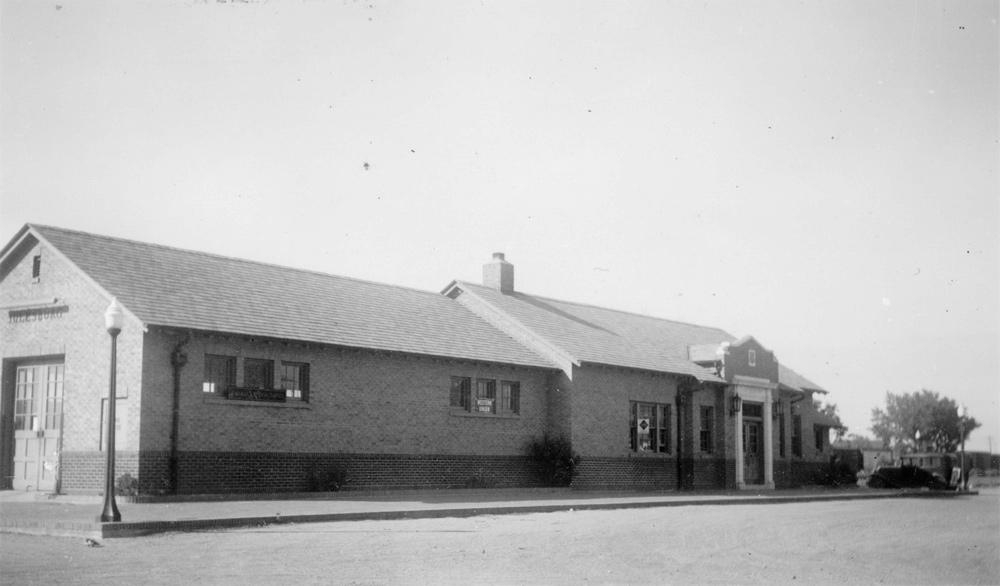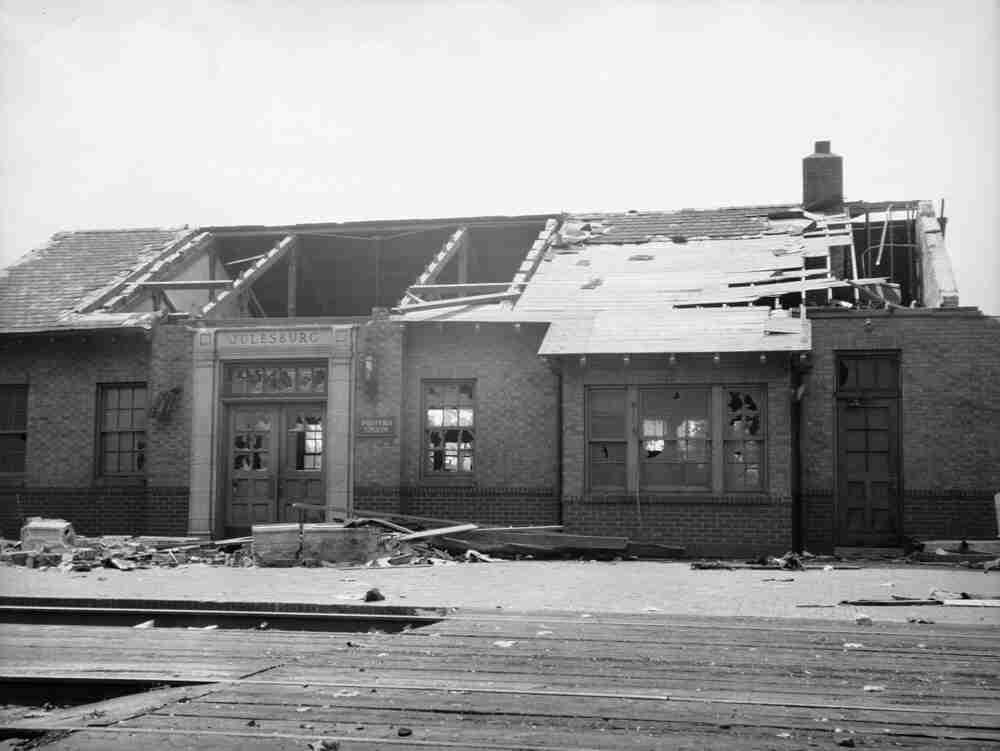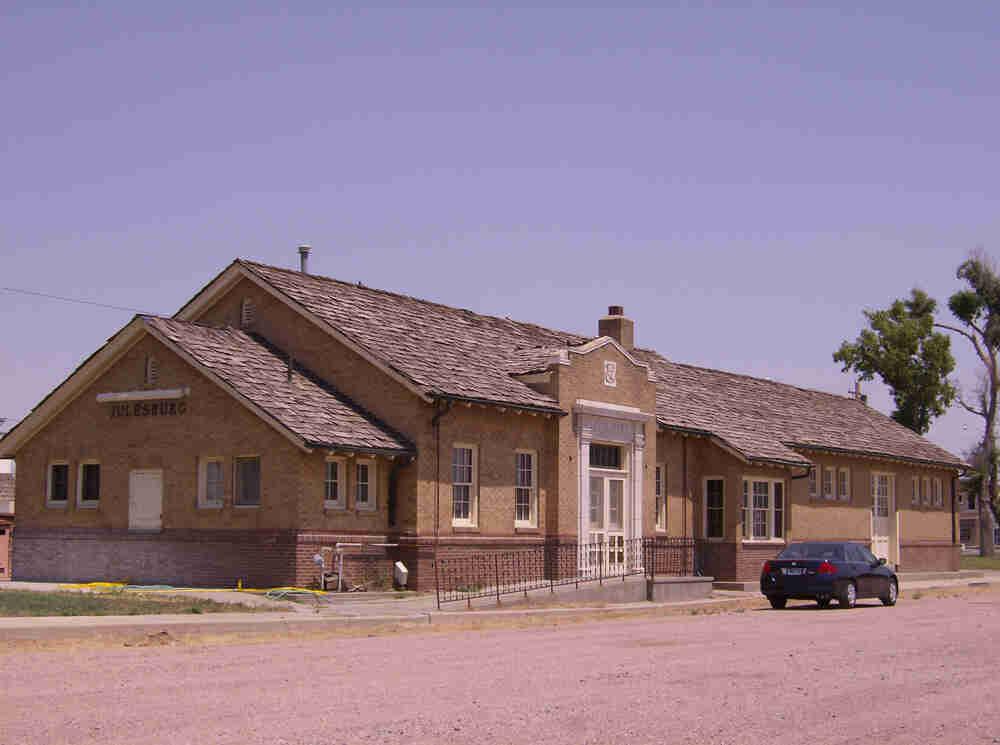Julesburg Union Pacific Depot
Full Article
Completed in 1930, the Union Pacific Railroad depot in Julesburg is a reminder of the town’s long-standing ties to the railroad. In the 1860s Julesburg served briefly as the end-of-track town when the Union Pacific was building its transcontinental line west, and the town even moved twice to improve its position along the railroad line. After passenger service to Julesburg ended in 1971, the depot was moved away from the tracks and reopened as a museum for local transportation history.
Railroad Town
Present-day Julesburg is the fourth town with that name established in northeastern Colorado. The history of all four towns is tied to the history of transportation, especially railroads, in the region.
Supposedly named after a French trader, the first Julesburg was founded in the 1850s on the south side of an important crossing of the South Platte River. In January 1865 it burned to the ground when Native Americans raided the town. Soon the second Julesburg was established a few miles away near Fort Sedgwick, a new post on the south side of the South Platte meant to protect overland wagon trains and stage lines.
The second Julesburg existed for little more than a year before residents learned that the Union Pacific’s transcontinental railroad route would follow the north shore of the river. In the spring of 1867, they abandoned the second Julesburg and established a third Julesburg along the Union Pacific route. The third Julesburg boomed that summer, when it served for a few months as the railroad’s end-of-track town. It gained a reputation as “the wickedest city in the West.”
After the railroad work crew moved on to Cheyenne, Wyoming, in the fall of 1867, this new Julesburg shrank once again to a small town. Also known as Weir, this Julesburg survived for more than a decade, until in 1881 Union Pacific built a branch connecting the transcontinental line to Denver. The branch hit the transcontinental line about four miles east of the third Julesburg, so the town picked itself up once more and relocated to Denver Junction, which became the fourth Julesburg in 1886.
The fourth Julesburg had a wooden railroad depot. The original building was enlarged over the years and continued to serve the town through the 1920s.
Brick Depot
By the late 1920s, local residents and merchants were starting to push for a new, modern depot in Julesburg. In 1929 Union Pacific agreed to spend $80,000 to erect a brick depot. Construction started that August. The new depot was a one-story building with a gable roof. It featured a standard Union Pacific combination-type depot design meant to handle passengers and baggage as well as freight and express shipments. The waiting room was in the center, with restrooms on one side and areas for ticketing and baggage on the other.
The dedication of the depot was originally planned for May 10, 1930, but it was delayed when a storm dropped four inches of rain and an inch of snow on the town. The depot was eventually dedicated on May 24, in a ceremony attended by about 2,000 people and featuring a reenactment of the burning of the first Julesburg.
Over the next few decades, the depot served as an important social hub and gathering spot in Julesburg. It was where the town received everything from news to eggs and milk, and it connected the town via rail to Denver and both coasts.
On June 6, 1947, a tornado hit the depot, ripping off part of its roof, and then doubled back and hit the depot again, demolishing some of the sidewalls. The depot remained in service during extensive repairs, which reused brick and tile from parts of the building that had collapsed.
Museum
When Amtrak assumed control over nationwide passenger-rail service in 1971, its routes bypassed Julesburg. With no need to serve passengers, Union Pacific planned to replace the brick depot with a small modular unit. Union Pacific announced in 1973 that it would demolish the old depot unless it was moved. Local citizens banded together with the city of Julesburg and the Fort Sedgwick Historical Society to save the depot by moving it 110 feet north and using it as a museum.
The moving project required $15,000 from the county, $5,000 from the Colorado Centennial-Bicentennial Commission, and tens of thousands of dollars in local fundraising, plus volunteer labor. The building had to be raised off its lower walls, towed north, and set down on a new concrete foundation at the corner of West First and Maple Streets. After an interior renovation, it reopened on July 12, 1975, as the Depot Museum, dedicated to local transportation history.
Owned by Sedgwick County and operated by the Fort Sedgwick Historical Society, the Depot Museum is open from Memorial Day to Labor Day each year.
10th Grade
Present-day Julesburg is the fourth town with that name established in northeastern Colorado. The history of all four towns is tied to the story of transportation, especially railroads, in the region.
Supposedly named after a French trader, the first Julesburg was founded in the 1850s on the south side of an important crossing of the South Platte River. In January 1865 it burned to the ground when Native Americans raided the town. Soon the second Julesburg was established a few miles away near Fort Sedgwick, a new post on the south side of the South Platte meant to protect overland wagon trains and stage lines.
The second Julesburg existed for little more than a year before residents learned that the Union Pacific’s transcontinental railroad route would follow the north shore of the river. In the spring of 1867, they abandoned the second Julesburg and established a third Julesburg along the Union Pacific route. The third Julesburg boomed that summer, when it served for a few months as the railroad’s end-of-track town. It gained a reputation as “the wickedest city in the West.”
After the railroad work crew moved on to Cheyenne, Wyoming, in the fall of 1867, this latest Julesburg shrank once again to a small town. Also known as Weir, this Julesburg survived for more than a decade, until in 1881 the Union Pacific built a branch connecting the transcontinental line to Denver. The branch met the transcontinental line about four miles east of the third Julesburg, so the town picked itself up once more and relocated to Denver Junction, which became the fourth Julesburg in 1886.
The fourth Julesburg had a wooden railroad depot. The original building was enlarged over the years and continued to serve the town through the 1920s.
Brick Depot
By the late 1920s, local residents and merchants were starting to push for a new, modern depot in Julesburg. In 1929 Union Pacific agreed to build a brick depot. Construction started that August. The new depot was a one-story building with a gable roof. It featured a standard Union Pacific depot design meant to handle passengers and baggage as well as freight and express shipments. The waiting room was in the center, with restrooms on one side and areas for ticketing and baggage on the other.
The depot was dedicated on May 24 in a ceremony attended by about 2,000 people, which featured a reenactment of the burning of the first Julesburg.
Over the next few decades, the depot served as an important social hub and gathering spot in Julesburg. It was where the town received everything from news to eggs and milk, and it connected the town via rail to Denver and both coasts.
On June 6, 1947, a tornado hit the depot, ripping off part of its roof. It then doubled back and hit the depot again, demolishing some of the sidewalls. The depot remained in service during repairs, which reused brick and tile from parts of the building that had collapsed.
Museum
When Amtrak assumed control over nationwide passenger rail service in 1971, its routes bypassed Julesburg. With no passengers to serve, Union Pacific planned to replace the brick depot with a small modular unit. Union Pacific announced in 1973 that it would demolish the old depot unless it was moved. Local citizens banded together with the city of Julesburg and the Fort Sedgwick Historical Society to save the depot by moving it 110 feet north and using it as a museum.
The building had to be raised off its lower walls, towed north, and set down on a new concrete foundation at the corner of West First and Maple Streets. After an interior renovation, it reopened on July 12, 1975, as the Depot Museum, dedicated to local transportation history.
Owned by Sedgwick County and operated by the Fort Sedgwick Historical Society, the Depot Museum is open from Memorial Day to Labor Day each year.
8th Grade
Present-day Julesburg is the fourth town with that name in northeastern Colorado. The history of all four towns is tied to the story of transportation, especially railroads, in the region.
The first Julesburg was founded in the 1850s on the south side of an important crossing of the South Platte River. In January 1865 it burned to the ground when Native Americans raided the town. Soon the second Julesburg was built a few miles away near Fort Sedgwick. The new fort was located on the south side of the South Platte River. Its purpose was to protect overland wagon trains and stage lines.
This second Julesburg lasted for little more than a year. Residents learned that the Union Pacific’s transcontinental railroad route would follow the north shore of the river. In the spring of 1867, they left the second Julesburg and established a third Julesburg along the Union Pacific route on the north shore of the South Platte. The third Julesburg boomed that summer. It served for a few months as the railroad’s end-of-track town. It had a reputation as “the wickedest city in the West.”
In the fall of 1867, the railroad work crew moved on to Cheyenne, Wyoming, and this latest Julesburg shrank once again to a small town. Also known as Weir, the third Julesburg survived for more than a decade until 1881, when the Union Pacific built a branch connecting the transcontinental line to Denver. The branch met the transcontinental line about four miles east of Julesburg. Once again, the town picked itself up and relocated to Denver Junction, which became the fourth Julesburg in 1886.
The fourth Julesburg had a wooden railroad depot. The original building was enlarged over the years and served the town through the 1920s.
Brick Depot
By the late 1920s, local residents and merchants were starting to push for a new, modern depot in Julesburg. In 1929 Union Pacific agreed to build a brick depot. Construction started that August. The new depot was a one-story building with a gable roof. It had the standard Union Pacific depot design meant to handle passengers and baggage as well as freight and express shipments. The waiting room was in the center, with restrooms on one side and areas for ticketing and baggage on the other.
Over the next few decades, the depot served as an important social hub and gathering spot in Julesburg. It was where the town received everything from news to eggs and milk, and it connected the town by rail to Denver and both coasts.
On June 6, 1947, a tornado hit the depot, ripping off part of its roof. Then it came back and hit the depot again, destroying some of the sidewalls. The depot remained in service during the repairs, which reused brick and tile from parts of the building that had collapsed.
Museum
When Amtrak took control over nationwide passenger rail service in 1971, its routes bypassed Julesburg. With no passengers to serve, Union Pacific planned to replace the brick depot with a smaller modular unit. Union Pacific announced in 1973 that it would knock down the old depot unless it was moved. Local citizens banded together with the city of Julesburg and the Fort Sedgwick Historical Society to save the depot by moving it and using it as a museum.
The building had to be raised off its lower walls, towed north, and set down on a new concrete foundation at the corner of West First and Maple Streets. After an interior renovation, it reopened on July 12, 1975, as the Depot Museum, dedicated to local transportation history.
4th Grade
Present-day Julesburg is the fourth town with that name to have been built in northeastern Colorado. The history of all four towns is tied to the history of railroads in the area.
The first Julesburg was founded in the 1850s on the south side of the South Platte River. In January 1865 it burned to the ground when Native Americans raided the town. Soon the second Julesburg was built a few miles away near Fort Sedgwick, a new army post on the south side shore of the South Platte River. Fort Sedgwick was meant to protect wagon trains and stage lines.
The second Julesburg lasted for less than a year. The people who lived there learned that the Union Pacific’s railroad route would follow along the north shore of the river. In the spring of 1867, the citizens left the second Julesburg and started a third Julesburg along the Union Pacific route. The third Julesburg grew that summer. It served as the railroad’s end-of-track town.
The railroad work crew moved on to Cheyenne, Wyoming in the fall of 1867. The third Julesburg shrank once again to a small town. Also called Weir, this Julesburg lived until in 1881. At that time Union Pacific built a branch connecting the railroad line to Denver. The branch was built about four miles east of the third Julesburg. In 1886 the town moved again to the new railroad junction and became the fourth Julesburg.
The fourth Julesburg had a wooden railroad depot. The original building was added to over the years through the 1920s.
Brick Depot
By the late 1920s, local residents and business owners wanted a new, modern depot in Julesburg. In 1929 Union Pacific agreed to build a brick depot. Construction started that August. The new depot was a one-story building. It was the usual Union Pacific depot, designed for passengers and baggage and freight and express shipments. The waiting room was in the center. Restrooms were on one side and ticketing and baggage on the other.
Over the next few decades, the depot served as a gathering spot in Julesburg. It was where the town got everything from news to eggs and milk. It connected the town by rail to Denver.
On June 6, 1947, a tornado hit the depot and badly damaged it. It stayed in service during the repairs.
Museum
In 1971 Amtrak took over nationwide passenger-rail service. Its routes passed by Julesburg. Union Pacific planned to replace the brick depot. In 1973 Union Pacific planned to tear down the old depot unless it was moved. Local citizens and others worked together to save the depot by moving it and using it as a museum. It reopened on July 12, 1975, as the Depot Museum, for local transportation history.






